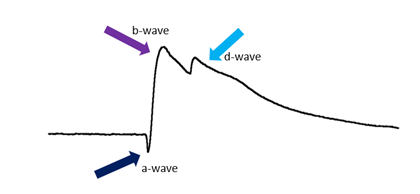Tiered Mentoring ProgramExploring the OFF-bipolar cell response in the zebrafish retinaDr. Jordan Renna and Aimee Saunders |
 |
 If you enjoy dark rooms, dim red fairy lights, black and white computer screens, trying to make sense of squiggly lines, excelling at Excel and making graphs, then the Renna Lab’s ERG project could be for you!
If you enjoy dark rooms, dim red fairy lights, black and white computer screens, trying to make sense of squiggly lines, excelling at Excel and making graphs, then the Renna Lab’s ERG project could be for you!
This is a hands-on research experience in which you will learn how to mix up chemical solutions, record electrical activity from a zebrafish retina in response to flashes of light, and then analyze and graph the data.
Students will need to have two 4-hour chunks of time during the school week (or one full day) starting in January. We also have a lab meeting once a week, so about 10 hours a week is the commitment.
Nitty Gritty Science:
 Our lab utilizes a procedure called Electroretinogram (ERG) to study the behavioral and physiological properties of the neural retina. This protocol has medical relevance and is routinely done by optometrists. It demonstrates the whole function of the retina and the role of several important cell populations. The a-wave of the ERG is related to total output of light detecting photoreceptor cells (rods and cones). The b-wave of the ERG is related to the output of the ON-bipolar cells as they response to light increase. The final component is the d-wave, which is generated by the OFF-bipolar cells in response to light decrease.
Our lab utilizes a procedure called Electroretinogram (ERG) to study the behavioral and physiological properties of the neural retina. This protocol has medical relevance and is routinely done by optometrists. It demonstrates the whole function of the retina and the role of several important cell populations. The a-wave of the ERG is related to total output of light detecting photoreceptor cells (rods and cones). The b-wave of the ERG is related to the output of the ON-bipolar cells as they response to light increase. The final component is the d-wave, which is generated by the OFF-bipolar cells in response to light decrease.
These cells form complex synapses that are needed for the transmission of visual information. Our project aims to investigate how the OFF-bipolar cell response is affected by changes in both physical and chemical environment in zebrafish. Very few labs work with zebrafish retina in this ex-vivo manner, so this approach is somewhat novel.
